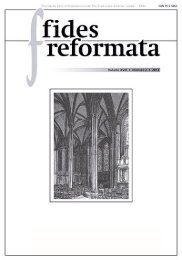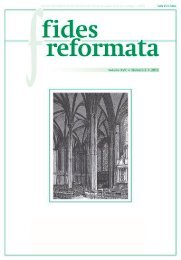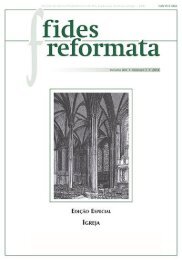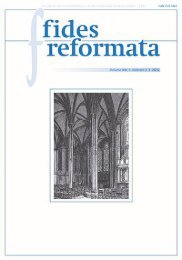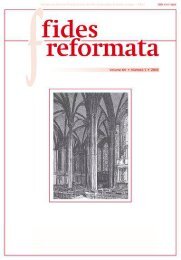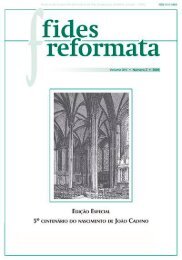Create successful ePaper yourself
Turn your PDF publications into a flip-book with our unique Google optimized e-Paper software.
FIDES REFORMATA XX, Nº 1 (<strong>20</strong>15): 89-105<br />
body in order that, through that register, the patriarch’s new status would be<br />
remembered. 62 In the mind of Calvin, the memorial aspect of circumcision is<br />
associated with the fact that it is called “the covenant of God.” Calvin explains<br />
that the association of the word of God (present here in the covenant concept)<br />
and the symbol is what makes it a sacrament. “A sacrament is nothing else that<br />
a visible word, or sculpture and image of that grace of God which the word<br />
more fully illustrates.” 63 Calvin, then, moves on to place upon the sacrament<br />
a particular function as a result of this relationship between word, sacrament,<br />
and faith: “It follows that the proposed end and use of sacraments is to help,<br />
promote and confirm faith.” 64 Calvin emphasizes this amazing role of the sacrament<br />
without destroying the power and authority of the word. Both must be<br />
present. He affirms: “And although we must maintain the distinction between<br />
the word and the sign; yet let us know, that as soon as the sign itself meets our<br />
eyes, the word ought to sound in our ears.” 65<br />
Concerning the significance of the sacrament, Calvin recognizes the<br />
necessity of an analogy between the thing signified and the sign. Due to this<br />
recognition, he initially expresses amazement for the choice of such unusual<br />
sign. His amazement, however, <strong>do</strong>es not hinder the great theologian to find an<br />
answer to the meaning for circumcision. He attributes to it two significances:<br />
the declaration of the corruption of the human race and the confirmation that<br />
such tragic state would be reverted by one belonging to the descendancy of<br />
Abraham. 66 In other words, the sign represents both removal of uncleanness<br />
and redemption. Such reasoning opens the <strong>do</strong>ors for Calvin’s later association<br />
of circumcision and baptism.<br />
Concerning the participants of the covenant, Calvin affirms the participation<br />
of both genders, male and female, in it, in spite of the administration<br />
of the sign being restricted only to males. He attributes the participation of<br />
women into the covenant to the necessity that both sexes have of its blessed<br />
62 “As formerly, covenants were not only committed to public records, but were also wont to<br />
be engraven in brass, or sculptured on stones, in order that the memory of them might be more fully<br />
recorded, and more highly celebrated; so in the present instance, God inscribes his covenant in the flesh<br />
of Abraham. For circumcision was a solemn memorial of that a<strong>do</strong>ption, by which the family of Abraham<br />
had been elected to be the peculiar people of God.” Calvin, Commentaries on Genesis, 1:451.<br />
63 Calvin, Commentaries on Genesis, 1:451. Calvin affirms the same even more emphatically:<br />
“By the figure metonymy, the name of covenant is transferred to circumcision, which is so conjoined<br />
with the word, that it could not be separated from it.” Calvin, Commentaries on Genesis, 1:453.<br />
64 Ibid., 1:452.<br />
65 Ibid.<br />
66 “Moreover, it is probable that the Lord commanded circumcision for two reasons: first, to show<br />
that whatever is born of man is polluted; then, that salvation would proceed from the blessed seed of<br />
Abraham.” Calvin, Commentaries on Genesis, 1:453-454.<br />
103






